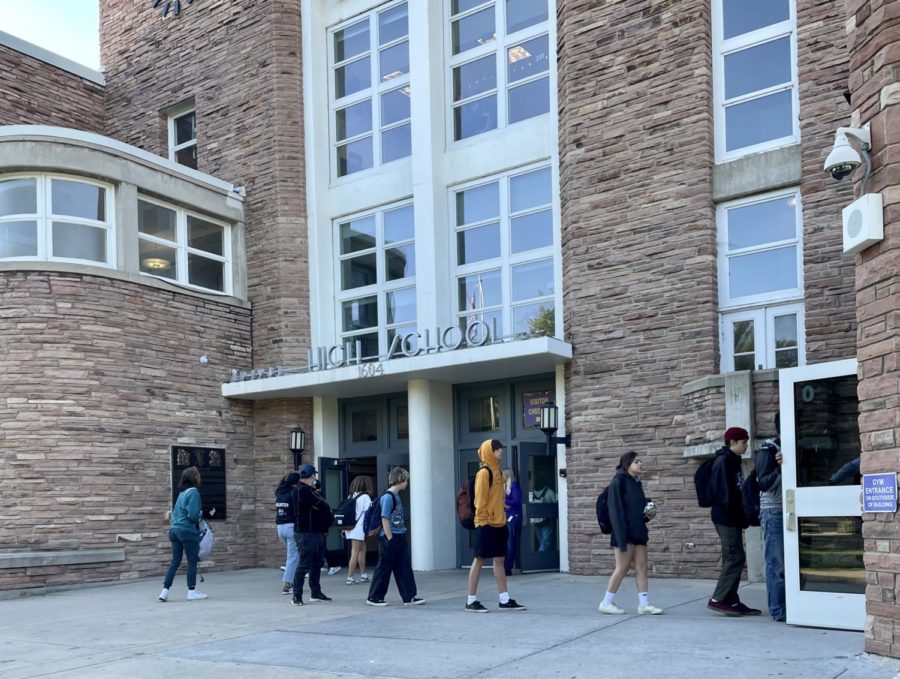(Re)Instated ID Policy Leads to More Confusion
According to Admin, IDs may be worn on a lanyard, which are available for purchase in the front office for $5.00, or on a clip.
At the end of last semester, many BHS students noticed a recurring trend in their emails: the school sent out various notices that “[b]eginning in January (second semester), all students will be required to wear their ID at all times while on campus.”
Of course, Administration loudly implemented this policy last semester, to limited effect. The biggest change was that most mornings, several adults stand at the doors and check that the thousands of students are holding school IDs (several students reported successfully showing them a debit card or fake ID ). Other doors are technically off-limits to students, although the success of that is more limited.
The email raised several questions: did the ID policy from last semester ever end? What was different this time?
Principal Dr. Morales explained that Boulder High’s administration team needed the past semester to sort out the policy, which was never really enforced. Early in the school year, a student from Fairview came into the building and walked past 11 adults, according to Morales. This incident and subsequent alleged episodes where other teenagers who do not attend the school came into the facility raised staff’s concerns about distinguishing who genuinely attends Boulder High.
Safety in schools is a hot-button topic. In 2022, for the first time, gun violence was the largest cause of death for people under 18, as reported by the New York Times. According to a report by the Kaiser Family Foundation, the majority of these deaths were not from school shootings, but 2022 was also one of the deadliest years on record for school violence owing to the 21 deaths from the shooting in Uvalde, Texas.
Schools, despite their inability to legislate the availability of firearms or many other factors that contribute to these massacres, are under immense scrutiny to facilitate student safety. One teacher I spoke with posited that the reason Boulder High implemented this policy was to minimize legal action following a shooting. In Oxford, Michigan, students are suing their school district for not enforcing safety measures following the deadly shooting at Oxford High School last year, according to NPR.
However, Mr. Bishop denied that any parental pressure was involved in the decision to implement the ID policy, and the principal said that it came entirely internally sans district-wide policy.
Some schools have metal detectors, some have police. Some people have even suggested arming teachers. After the social media threat to Fairview this October, parents proposed (or threatened, depending on your perspective) to “guard” the school with firearms themselves, according to the Boulder Reporting Lab. The effectiveness of both these measures is questionable; according to experts, the best solution is gun control, which schools cannot do anything about.
During class meetings on Friday, January 6th, Mr. Bishop stated that not wearing an ID would result in consequences. Morales and Bishop both clarified later that they didn’t view said consequences, which ultimately is a meeting with a student, their parents, and administrative, as punitive. Charlotte Zana ‘24 said that she only wore her ID because she is on Student Council and “just wants Admin to not hate me.” I met with Dr. Morales twice and Mr. Bishop once for this story and did not wear my ID. Morales only noted it the first time and Bishop didn’t at all. The principal remarked that she didn’t want to have to “nag” the 2200-odd students. Bishop also mentioned that teachers were asked to enforce the policy.
Several weeks later, social studies teacher Ms. Howe said that Administration had told teachers not to carry out the policy as a disciplinary action. Only a few of her students wear their IDs, and sending 30+ kids to the office every period would be incredibly disruptive.
Most students do not wear their IDs. Freshman Diego Almeda is in that majority, saying that “it’s boring” and that he doesn’t want people to see his picture. He also stated that he doesn’t feel secure in school but that everybody wearing their IDs wouldn’t make him feel safer. Hayden Leovy ‘24 thought that most students don’t wear lanyards because “it’s not cool,” but said he wore his because it took out the hassle of having to find his ID every time he went through a door. “I don’t think IDs help [safety] a whole lot but they probably help a little.”
Dr. Morales said that wearing an ID should be a collective decision for communal safety. Bishop noted that “what’s popular isn’t always right and what’s right isn’t always popular.” It’s difficult- if not impossible -to enforce that policy if student culture doesn’t change.
Government teacher Mr. Kingsley said that the idea of student culture is also dependent on the idea of the social contract. “People won’t behave because they’re forced to behave- if they do, it’s a short term thing. People behave when the reason why they behave allows them to be in a group that benefits them.” In terms of the ID policy, students are not likely to comply until they see a direct advantage to doing so. Students don’t think it’s worth it. Students don’t think it’s worth it.

Hannah (rhymes with fauna!) Cohen is ecstatic to be working on the Owl for her third and final year. She loves stories in all their forms, but she mostly has opinions on obscure podcasts and which New York Times opinion columnists are defacing the good name of journalistic analysis. When not busy with stumbling through sheet music, editing nonfiction for jGirls+ Magazine, or seeking out the cheapest bluegrass venue, Hannah enjoys wandering around the mountains with her friends and lovely labradoodle. Although she's slightly preferential to the sweeter, more robust taste of red grapes, she knows that the bliss of biting into a crunchy grape transcends color.


